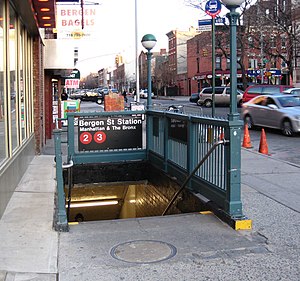Bergen Street station (IRT Eastern Parkway Line)
Bergen Street | |||||||||||
|---|---|---|---|---|---|---|---|---|---|---|---|
 | |||||||||||
| Station statistics | |||||||||||
| Address | Bergen Street & Flatbush Avenue Brooklyn, NY 11217 | ||||||||||
| Borough | Brooklyn | ||||||||||
| Locale | Park Slope | ||||||||||
| Coordinates | 40°40′51″N 73°58′30″W / 40.680833°N 73.97511°W | ||||||||||
| Division | A (IRT)[1] | ||||||||||
| Line | IRT Eastern Parkway Line | ||||||||||
| Services | 2 3 4 | ||||||||||
| Transit | |||||||||||
| Structure | Underground | ||||||||||
| Platforms | 2 side platforms | ||||||||||
| Tracks | 6 | ||||||||||
| Other information | |||||||||||
| Opened | October 10, 1920 | ||||||||||
| Opposite- direction transfer | No | ||||||||||
| Traffic | |||||||||||
| 2023 | 990,992[2] | ||||||||||
| Rank | 294 out of 423[2] | ||||||||||
| Station succession | |||||||||||
| Next north | Template:NYCS next | ||||||||||
| Next south | Template:NYCS next | ||||||||||
| |||||||||||
| |||||||||||
| |||||||||||
Bergen Street is a local station on the IRT Eastern Parkway Line of the New York City Subway, located at Bergen Street and Flatbush Avenue in Park Slope, Brooklyn. It is served by the 2 at all times, the 3 at all times except late nights, and the 4 train during late nights.
History
Track layout | |||||||||||||||||||||||||||||||||||||||||||||||||||||||||||||||
|---|---|---|---|---|---|---|---|---|---|---|---|---|---|---|---|---|---|---|---|---|---|---|---|---|---|---|---|---|---|---|---|---|---|---|---|---|---|---|---|---|---|---|---|---|---|---|---|---|---|---|---|---|---|---|---|---|---|---|---|---|---|---|---|
| |||||||||||||||||||||||||||||||||||||||||||||||||||||||||||||||
On October 10, 1920, three stations that were not ready to be opened with the rest of the line, at Bergen Street, Grand Army Plaza and Eastern Parkway–Brooklyn Museum, were opened.[4]
During the 1964–1965 fiscal year, the platforms at Bergen Street, along with those at four other stations on the Eastern Parkway Line, were lengthened to 525 feet to accommodate a ten-car train of 51-foot IRT cars.[5]
Station layout
| G | Street Level | Exit/Entrance |
| B1 | Mezzanine | Fare control, station agent |
| B2 | Side platform, doors will open on the right | |
| Northbound local | ← ← | |
| Curtain wall | ||
| Northbound express | ← | |
| Northbound Brighton Line | ← | |
| Southbound Brighton Line | → | |
| Southbound express | → | |
| Curtain wall | ||
| Southbound local | → → | |
| Side platform, doors will open on the right | ||
The station contains six tracks and two side platforms: the outermost tracks are used by the IRT local trains. To the inside are the IRT express tracks, which slant upward to the inside of the outer local tracks. In between the express tracks are the BMT Brighton Line tracks. Those routes were built at the same time as the tracks at this station as part of the Dual Contracts. A full curtain wall separates the local from the express tracks, though a gap exists in the curtain wall at the end of the station.
Both platforms have their original mosaics. The name tablets read "BERGEN ST." in gold Times New Roman font on a blue background and multi-layered green border. The trim line is green with "B" tablets on them on a blue background at regular intervals. At either ends of both platforms, where they were extended in 1964–1965,[5] there are cinderblock tiles with signs reading "BERGEN ST" in sans serif font on a maroon background.
The platforms only have columns at the fare control areas and they are i-beam columns painted green.
Exits
Each platform has one same-level fare control area at the center and there are no crossovers or crossunders. The Manhattan-bound platform has the full-time turnstile bank and token booth and two staircases going up to either eastern corners of Bergen Street and Flatbush Avenue. The southbound platform's fare control area is unstaffed, containing a bank of three regular turnstiles, two exit-only turnstiles, and two High Entry/Exit Turnstiles. Outside fare control are two staircases going up to the southwest corner of Flatbush Avenue and Bergen Street and a passageway leading to another staircase going up to the northwest corner.[6]
References
- ^ "Glossary". Second Avenue Subway Supplemental Draft Environmental Impact Statement (SDEIS) (PDF). Vol. 1. Metropolitan Transportation Authority. March 4, 2003. pp. 1–2. Archived from the original (PDF) on February 26, 2021. Retrieved January 1, 2021.
- ^ a b "Annual Subway Ridership (2018–2023)". Metropolitan Transportation Authority. 2023. Retrieved April 20, 2024.
- ^ "Annual Subway Ridership (2018–2023)". Metropolitan Transportation Authority. 2023. Retrieved April 20, 2024.
- ^ "Subway Stations Opened: Last Three in Eastern Parkway Branch of I.R.T. Put Into Service" (PDF). New York Times. October 11, 1920. Retrieved 20 December 2015.
- ^ a b Annual Report 1964–1965. New York City Transit Authority. 1965.
- ^ "MTA Neighborhood Maps: Park Slope/Prospect Park" (PDF). mta.info. Metropolitan Transportation Authority. 2015. Retrieved 2 August 2015.
External links
- nycsubway.org
- Brooklyn IRT: Bergen Street (text used with permission)
- Brooklyn IRT: Map 2, Brooklyn IRT Dual Contracts (includes current and former track configurations, and provisions for future connections)
- Station Reporter — 2 Train
- Station Reporter — 3 Train
- The Subway Nut — Bergen Street Pictures
- Bergen Street entrance from Google Maps Street View
- Northbound platform from Google Maps Street View




